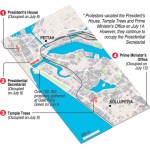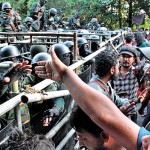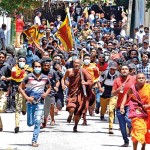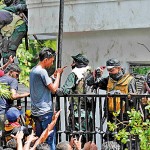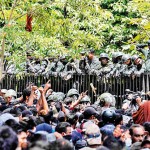News
Protest Wednesday forays: The conquest and the clashes
View(s):By Sandun Jayawardana
Initially, the mood at “Gota Go Gama” (GGG) in Galle Face was upbeat on the morning of Wednesday (13) as news filtered in that President Gotabaya Rajapaksa had fled the country on a Sri Lanka Air Force (SLAF) aircraft headed for the Maldives.
By 8 a.m., a large crowd had already gathered at the site. People were taking group photographs and selfies wrapped in national flags. With Speaker Mahinda Yapa Abeywardena having earlier announced that Mr Rajapaksa had conveyed his intention to step down on July 13, there was an expectation in the air that an official announcement would follow.
The mood soon changed, however, as it became clear that Prime Minister Ranil Wickremesinghe, whose resignation had also been demanded by the protesters, was not stepping down. In fact, reports came that he had been appointed Acting President. Soon, a large crowd started marching from Galle Face to the Prime Minister’s Office on Flower Road. They were met by barricades and a wall of police and armed forces personnel. As protesters tried to break through the barricades and march on the building, they were hit by rounds of tear gas and water cannon. Several canisters were picked up by protesters, who hurled them back the way they had come.
Some protesters were overcome by tear gas, but the crowds kept coming. As those at the front were injured or overcome, they were carried back or taken on the back of several lorries, with the crowds parting to let them through. Ambulances kept rushing to and from the site.
As the injured were taken away, those at the back were urged to go forward, with cries of “Aragalayata Jayawewa” (Long Live the Struggle) and “Thawa Tikai, Thawa Tikai. Atha Arinna Epa” (We are so close. Don’t give up now). Bottles of water were brought in from vehicles and distributed among the protesters to help them wash off the effects of tear gas.
The vast majority of those in the crowd were young men and women, but there were middle-aged and some elderly persons among the protesters, too. “I’m 63 years old and live alone. I don’t need to be out in the streets, but this is my fifth protest. I came here today with my neighbour because I’m just sick of what’s happening and want a change,” said one woman.
Eventually, as they had done at the President’s House, the Presidential Secretariat and Temple Trees, the protesters overwhelmed the police and soldiers by sheer weight of numbers. Police and armed forces personnel stood down and the building fell into the hands of the protesters.
They immediately opened the Prime Minister’s office to the public. Crowds had to line up and enter through the main door, but some still found side entrances to enter different parts of the building. Protesters had just settled into a large office room when someone put on the TV to watch coverage of their protest. There were jeers when Acting President Ranil Wickremesinghe’s statement on the incident came on. Some clicked selfies of themselves watching the statement from the PM’s office. Others went around taking down photographs hanging from the room’s walls and collecting them in one place. “We don’t want them to be damaged or for someone to take them home as souvenirs,” said one.
At least 42 people were injured and hospitalised in the protest at the PM’s office. A 26-year-old protester who suffered breathing difficulties from inhaling tear gas later died at a private hospital.
There was further unrest near Polduwa Junction near Parliament later on Wednesday night when groups of protesters attempted to march towards the Parliament complex. Some of the organisers of the “Aragalaya” (Struggle) distanced themselves from the protest, urging crowds not to gather around Parliament. The Sunday Times, however, saw some sections at both President’s House and Temple Trees in the evening calling on people to march towards Parliament.
A further 42 persons were injured and hospitalised due to the incidents near Parliament. A total of 84 persons — 79 men and five women — injured during the protests at both the PM’s office and near Parliament were admitted to the National Hospital in Colombo.
Scores of soldiers, too, were injured in the unrest near Parliament, with two suffering serious injuries after being severely assaulted. They are being treated at the Army Hospital. Meanwhile, the Colombo Crime Division (CCD) has opened an investigation into a complaint that the two T-56 assault rifles of the severely injured soldiers, together with their magazines, had been stolen. The weapons are yet to be recovered and no arrests have been made in connection with the incident.
On Thursday (14), protest leaders announced that they would vacate the President’s House, Temple Trees and the PM’s office in line with an appeal made by Speaker Mahinda Yapa Abeywardena to facilitate a peaceful environment to prevail. Protesters, however, will continue to occupy the Presidential Secretariat and the Galle Face, Green (GGG), they added.
At GGG, protesters had earlier put out a six-point action plan regarding the way forward. It includes the resignations of both Gotabaya Rajapaksa and Ranil Wickremesinghe. It also calls for the setting up of an interim governing structure with a “People’s Council” with legal standing for representatives of the struggle to effectively mediate and engage with the interim government.
“We are withdrawing from these buildings but our struggle will continue in other ways,” Inter-University Students’ Federation (IUSF) convener Wasantha Mudalige, said, as the last group of protesters who had been occupying the building since July 9 were leaving. He said protesters were not prepared to recognise Ranil Wickremesinghe as acting president and want him to resign as well. “We have no quarrel with the buildings. By taking over places like the President’s House, we showed that Gotabaya Rajapaksa has no power. He is finished now, but our struggle continues.”
Though the buildings were handed over after being cleaned, there were visible signs of damage to property at all three locations. Officials are only now able to make a full assessment of the damage.
Pix by Indika Handuwala, M.A. Pushpa Kumara and Akila Jayawardana
| Eighty four injured at this week’s protests; many treated and discharged 26 year old protester dies after facing critical breathing difficulties from tear gas exposure A majority of the 84 people who were injured in this week’s protests were treated at the Accident Service in Colombo and have been discharged, hospital sources said. Around 40 people were injured when protestors stormed into the Prime Minister’s residence on Wednesday. On the same day at least 42 people were injured at Polduwa junction when protestors who attempted to enter Parliament premises clashed with military personnel. Injuries varied from wounds, bruises and falls as well as exposure to tear gas and breathing difficulties. Accident Service spokesperson and head nurse Pushpa Ramyani Soysa said by the weekend, many of the injured people were discharged. “There were no critical cases. Most were treated and discharged the next day,” she said. Among the injured were 79 males and five females. One military personnel, two Police officers and two journalists were among the injured. A 26 year old protester died at a private hospital in Colombo, due to a respiratory ailment after being exposed to a tear gas attack at the Prime Minister’s residence. |
The best way to say that you found the home of your dreams is by finding it on Hitad.lk. We have listings for apartments for sale or rent in Sri Lanka, no matter what locale you're looking for! Whether you live in Colombo, Galle, Kandy, Matara, Jaffna and more - we've got them all!


